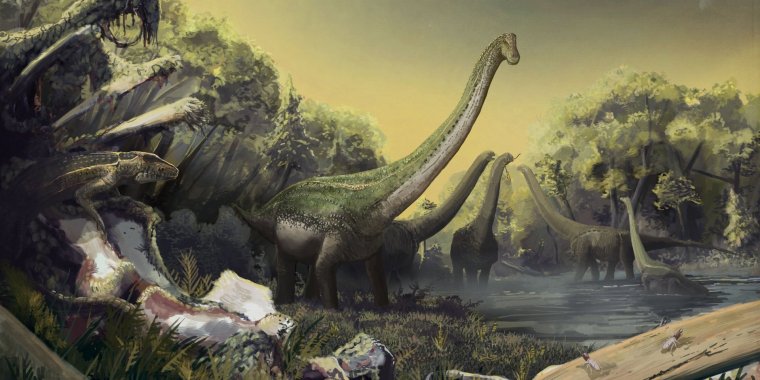| News / Science News |
Paleontologists discover new species of sauropod dinosaur in Tanzania
Paleontologists have identified a new species of titanosaurian dinosaur. The new species is a member of the gigantic, long-necked sauropods. Its fossil remains were recovered from Cretaceous Period (70-100 million years ago) rocks in southwestern Tanzania.

Reconstruction of the new titanosaur and the landscape in which it lived, in what is now Tanzania. ![]()
Titanosaur skeletons have been found worldwide, but are best known from South America. Fossils in this group are rare in Africa.
The new dinosaur is called Shingopana songwensis, derived from the Swahili term "shingopana" for "wide neck"; the fossils were discovered in the Songwe region of the Great Rift Valley in southwestern Tanzania.
Part of the Shingopana skeleton was excavated in 2002 by scientists affiliated with the Rukwa Rift Basin Project, an international effort led by Ohio University Heritage College of Osteopathic Medicine researchers Patrick O'Connor and Nancy Stevens.
Additional portions of the skeleton -- including neck vertebrae, ribs, a humerus and part of the lower jaw -- were later recovered.
There are anatomical features present only in Shingopana and in several South American titanosaurs, but not in other African titanosaurs.
The team conducted phylogenetic analyses to understand the evolutionary relationships of these and other titanosaurs.
They found that Shingopana was more closely related to titanosaurs of South America than to any of the other species currently known from Africa or elsewhere.
This discovery suggests that the fauna of northern and southern Africa were very different in the Cretaceous Period. At that time, southern Africa dinosaurs were more closely related to those in South America, and were more widespread than we knew.
Shingopana roamed the Cretaceous landscape alongside Rukwatitan bisepultus, another titanosaur the team described and named in 2014.
During the tectonically active Cretaceous Period, southern Africa lost Madagascar and Antarctica as they split off to the east and south, followed by the gradual northward "unzipping" of South America.
Northern Africa maintained a land connection with South America, but southern Africa slowly became more isolated until the continents completely separated 95-105 million years ago. Other factors such as terrain and climate may have further isolated southern Africa. (National Science Foundation)
YOU MAY ALSO LIKE



